Why do people buy houses in places prone to flooding?
- Published
- comments
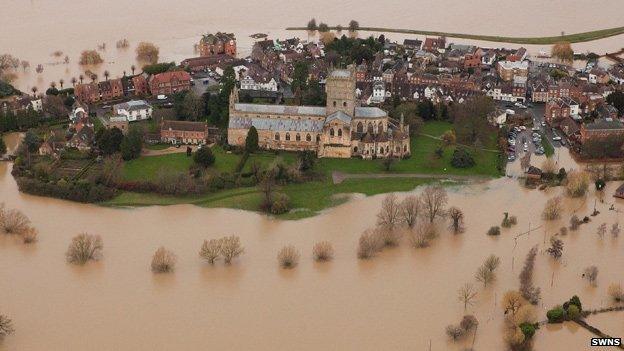
Tewkesbury has been indundated four times in recent years
Floods have brought chaos to homes in many parts of the UK. But do house prices dramatically fall in flood areas and if not, why not?
There's a poignant image of the picturesque town of Tewkesbury flooded this week, its famous abbey surrounded by the brown waters of the Severn.
The image is near identical to one from 2007. A casual viewer might well be tempted to ask: "Who would live in a place like this?"
After all, plenty of property purchasers can be put off by a survey that comes back with damp or a bit of subsidence.
The Environment Secretary, Owen Paterson, was asked this week why house building is still going on in flood plains. But surely the question is why people are still buying houses in flood plains. Or continuing to live in places that have suffered catastrophic floods.
One might assume that there would be massive falls in property prices after a highly publicised episode of damaging flooding.
But the figures don't seem to back that up.
If you take a place like Tewkesbury, you can see that the floods of 2007 did not significantly affect prices.
In June 2007, the average property value in the historic market town was £241,821. It dropped slightly to £238,200 in July, the month floods hit - when the average property price in England was £258,855. But the average price stayed consistently about the £240,000 mark for the rest of the year, according to figures collated by property website Zoopla.
Prices in Tewkesbury have dropped since, but not at a vastly disproportionate rate to the rest of England. Tewkesbury's average property is now £215,322, with the average value in England £236,134.
It's a similar picture in parts of Cumbria that were heavily affected by floods in 2009, and also less severely in 2005.
In October 2009, the average property value in Cockermouth, was £217,243, dropping to £213,234 in November - when floods hit. Today the average property price is £208,749, according to Zoopla.
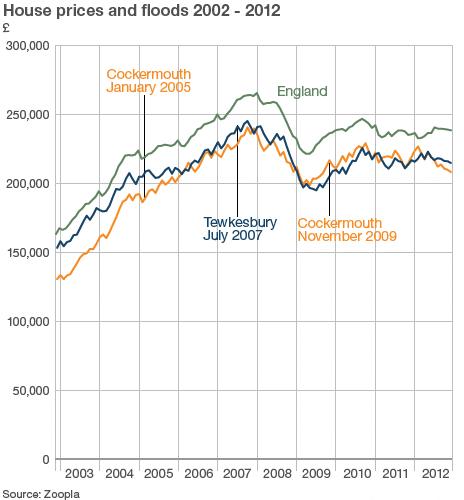
Of course there is only so much that can be extrapolated from figures collated by property companies. There are locations within locations, and varying property sizes.
But there are estate agents in flood-hit places like Tewkesbury, Hull, Carlisle and York who suggest that although prices tend to fall, generally by about 10%, just after a flood, they remain largely unaffected in the long run.
People see severe flooding as a one-off event, according to Jonathan Harris, director at property finance broker Anderson Harris. Even if houses have been flooded before, prospective buyers may spot ways in which they can flood-proof them.
And of course, most of the people who live in places like Tewkesbury and Cockermouth have lived there a long time, and like living there.
"My partner bought a place in the newly developed Walton Cardiff in 2010. It's on a flood plain, but it's slightly raised. There is water nearby now, but the property's fine," says 28-year-old Sophia Spencer, a lettings manager at Andrews estate agent in Tewkesbury.
"People outside the area seem a lot more wary about buying in Tewkesbury than people who live here. But it's a lovely market town with lots of black and white houses and tea rooms. I've lived here all my life so the floods don't put me off," she says.
Living somewhere picturesque for a slight discount can warrant some people taking a calculated gamble.
"Tewkesbury has beautiful old buildings, with unbelievable views. Some people think that outweighs the odd flood," says Anthony Rhodes, of Rhodes Real Estate in Tewkesbury.
Stuart Chester, who lives in Purley on Thames, just outside Reading, says he was fully aware that the property he bought 20 years ago was prone to flooding when he purchased it.
"Having a river at the bottom of the garden was a big attraction, as I like to do a bit of fishing. [And] it felt like a nice community," he says.
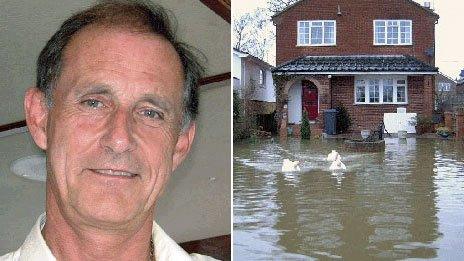
Stuart Chester, and his garden during a previous flood
The 68-year-old says the setting of the property, overlooking the Chilterns, and its proximity to Reading, also influenced his decision, and he thought the "inconvenience" of a flood every couple of years was worth it.
Since then his garage, garden and cellar have been flooded about 10 times, but as the house was built above the level of the great floods of 1947, it has escaped unscathed.
"For a home in such a delightful setting, it's a small price to pay," he says.
Of course for many people living in a flood risk area, it comes at a far greater cost. The 48,000 homes affected by the 2007 floods cost, on average, between £20,000 and £30,000 to repair, while the cost to the economy was £3.2bn, according to an Environment Agency report, external.
About 30% of householders had to move out while repairs were carried out, with one in 10 displaced for more than a year, creating a huge disruption to home life.
Some of the UK's most devastating floods
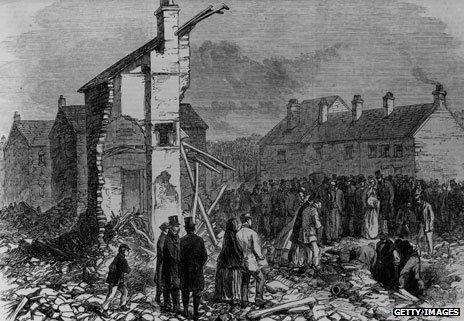
Sheffield, 1864: More than 200 people died after Dale Dyke Dam collapsed, emptying a reservoir across parts of the city
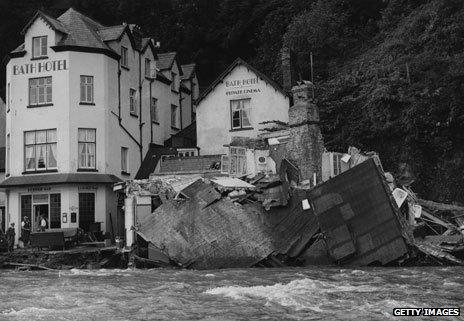
Lynmouth, 1952: Devon coastal village devastated after water and debris cascade from waterlogged Exmoor - 34 killed and 420 left homeless
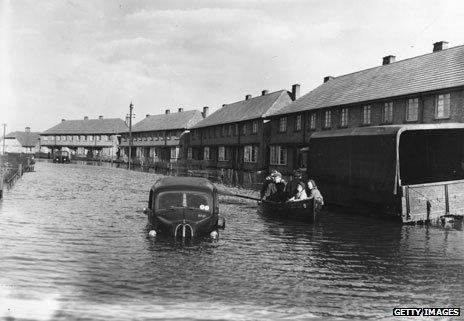
North Sea flood, 1953: Storm tides kill 307 people across east coast of England, 58 of them in Canvey Island in Essex (pictured)

UK, 2007: Series of floods across UK prompted biggest civil and military rescue effort in UK history - 13 people died
Then there is the worry over insurance, with the Association of British Insurers warning 200,000 homes in high-risk flood areas could be left without cover after June 2013, which could in turn affect mortgage offers.
For some existing homeowners, there is concern they could become trapped in properties that are practically unsellable.
Spending more on flood defences is one option. But for some people, the obvious solution is to build new properties away from areas prone to flooding.
A 2011 report, external by a government advisory group, the Committee on Climate Change, found that tens of thousands of properties were still built on flood plains around the UK - around 12,000 to 16,000 every year in England alone. A BBC investigation found a similar pattern in Wales.
"Rightly or wrongly, many communities feel that a lot of these new developments have contributed to the flooding," says Helen Shepherd from the National Flood Forum.
"Some say properties are being built on land that used to take in the water slowly. They also feel these developments are often plugged into an ageing draining infrastructure, which communities feel is beyond their capacity."
Kiran Curtis, principal at KCA architects, says the basic issue is that development is generally encouraged within urban areas, rather than within green belts, with a preference for previously developed land.
"If you look at places like Sheffield, or other parts of Yorkshire, local authorities want to try and regenerate old industrial and mill towns, which are often near rivers. There is a conflict, in that for good reason they want to bring urban centres back to life, but there's a historic problem that they do flood and can lead to development within flood plains," he says.
The Environment Agency says one in six homes in England is now at risk of flooding.
But Shepherd warns that the nature of flooding is changing, and increasingly anyone could be at risk.
"About 80% of flooding this summer was surface water flooding, so it is not just people that live on flood plains that are affected," she says.
Sue Tapsell, head of the Flood Hazard Research Centre, agrees.
"What we are seeing now is more flooding from pluvial events from intense summer storms. It means flooding, which tended to be the result of coastal tides or river floods - so we knew the most at risk places - is more unpredictable. It could happen everywhere."
You can follow the Magazine on Twitter, external and on Facebook, external